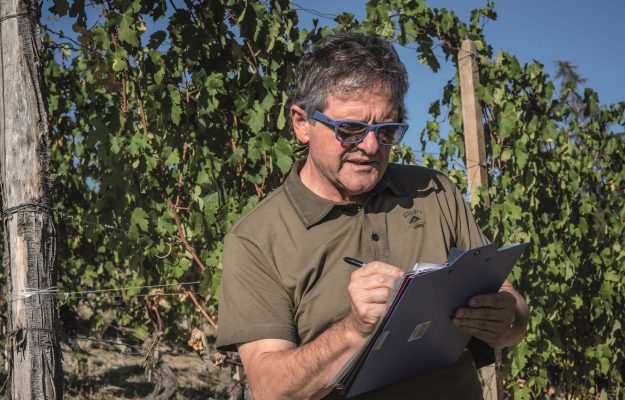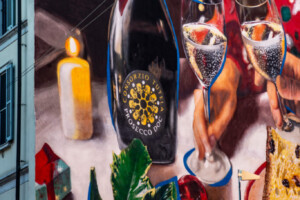In the wake of climate change, Italian vignerons will not have to completely undo traditional viticulture, made up of terroirs, DOC, DOCG, nor will they have to use hybrids or plant vineyards at higher latitudes and altitudes, and then have to replace the native varieties that have adapted over the centuries. This is the assumption that has convinced Donato Lanati, one of the most successful Italian oenologists, founder of the “Enosis Meraviglia” Research Laboratory and consultant to the most prestigious names in wine in Italy and France, of the fact that “research in viticulture and in enology will allow us to preserve our vineyards, our territories and our iconic wines. We must use our knowledge as a lever. For instance, a vineyard transpires between 350 and 700 liters of water for each liter of wine produced: 55% of water is consumed during the period from fruit set to veraison and 20% between veraison and the harvest. Therefore, water becomes a precious commodity, and if it were possible to do targeted irrigation, we could have already solved half the problem”.
However, there are many other measures that can be implemented in the vineyard to reduce the influence of high temperatures on the grapes, and be able to respond to the effects of climate change, and above all global warming. Protecting the grape bunches with an umbrella at the top of the row, abolishing topping and eliminating the females, which transpire more water; resorting to the use of nets to increase shading the vineyards or panels to tend to the ideal temperature of 27 degrees centigrade at the height of foliage; in green pruning we must keep in mind that the adult leaves transpire less than the young ones aged less than 35 days; guaranteeing the ratio leaf surface/weight of the bunches of 1.5/2 m2 for each kilo of grapes; carrying out peeling only on the less exposed side of the row; studying treatments that make the vine more resistant to water stress, using bio stimulant products derived from yeasts and bacterial extracts, rich in proline which modify transpiration; using zeolite and kaolin treatments on the grapes, which reduce loss of water through transpiration and also lower the temperature of the berry.
“At temperatures that approach 35° C, in the first instance, we have an increase in photosynthesis, and consequently high production of sugars. At the same time, there is a dizzying drop in acidity and an increase in pH,” Lanati explained. “Above 37° C, photosynthesis is blocked and the plant goes into stress. At temperatures of 35° C the grapes exposed to the sun's rays reach 45-50° C internally, and a consequent oxidation of the aromas, resulting in a wine that will express hints of jam and marmalade. In berries of red grapes exposed to the sun, instead, the tannins are also oxidized, and once they have passed from the skins to the must, they will have a limited possibility of reacting with the anthocyanins and forming a stable and long-lasting color”. In the last few years, in some areas, ripening has been 2-4 weeks early, but with great variations among the different berries of the same bunch. “We are fully aware that quality is achieved only when all the grapes of the same bunch have reached the same ripening, otherwise the high quality of the wines will be compromised”.
Various measures can be used to deal with climate change in viticulture, and Lanati also insisted on the resistance/effectiveness of rootless plants. Before the advent of phylloxera in Europe (1863), the vines cultivated throughout the world were ungrafted ( of the 2 million hectares cultivated, some areas that have different soils and climates are still ingrafted); that is, they did not use the American rootstock. In addition to being more long-lived (they live over 100 years), the free-standing vines show greater resistance to drought than the American ones, are very resistant to water and thermal stress, transpire only 150 liters per liter of wine and the quality/finesse of the wines is exceptional.
Moreover, it is becoming essential to experiment with ungrafted soils in anti-phylloxeric soils, siliceous, acidic, volcanic or cold soils in winter; or, correct clay soils or better, still increase resistance to root phylloxera or leaf gallecule, using sustainable biodegradable composts. Furthermore, starting from the awareness that 80% of the biological life of a vineyard takes place in the soil and that the quality and quantity result depends on it, the processes must aim to maintain the maximum degree of humidity. Therefore, we must use organic matter and, humus, to maintain the micro and macro biome, essential for correct nutrition and the physiology of the plant.
Consequently, a new frontier in scientific research has been opened by studying cuttings that were taken into space (ThalesAlenia Space). After having experienced the particular situation of microgravity, they seem to react against fungal diseases and phylloxera by expressing characteristics of resistance. “This”, Donato Lanati, consultant to the most prestigious names in wine in Italy and France and founder of the “Enosis Meraviglia” Research Laboratory, commented, “would allow ungrafted plants to communicate directly — and no longer through a rootstock — with the soil /territory, which is the true wealth of enology”.
Copyright © 2000/2025
Contatti: info@winenews.it
Seguici anche su Twitter: @WineNewsIt
Seguici anche su Facebook: @winenewsit
Questo articolo è tratto dall'archivio di WineNews - Tutti i diritti riservati - Copyright © 2000/2025









































































































































































































